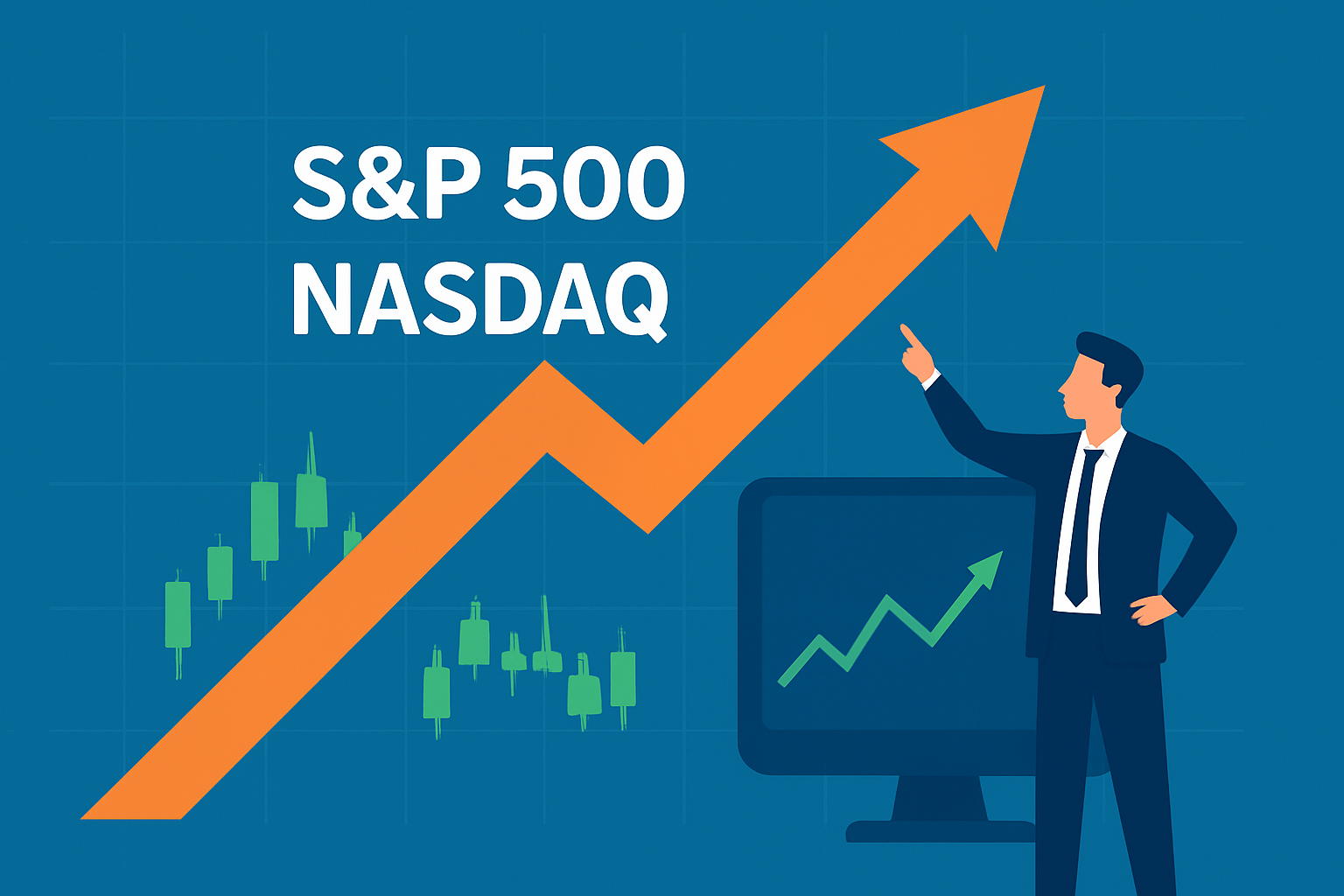A wave of optimism is sweeping through Wall Street as investors double down on risk assets, pushing the S&P 500 and Nasdaq Composite to fresh record highs. The rally, led by heavyweight AI and technology stocks, reflects growing confidence that the U.S. Federal Reserve will begin a series of interest rate cuts in the coming months—a move that could further bolster valuations and liquidity in equity markets.
According to Reuters and Investors Business Daily, traders are now pricing in at least two rate cuts before year-end, as inflation data continues to moderate and economic growth shows signs of cooling. With the Fed pivoting toward a more accommodative stance, tech-driven enthusiasm has turned into a full-blown momentum surge—raising both opportunities and risks for investors navigating a market at the crossroads of exuberance and caution.
Monetary Easing Narrative Powers Market Momentum
The S&P 500 gained 0.9% this week to close above 5,700, while the Nasdaq surged 1.4%, buoyed by tech giants such as Nvidia, Microsoft, Alphabet, and Amazon. The Philadelphia Semiconductor Index (SOX) also jumped more than 2%, marking its best weekly performance in over a month.
“Markets are front-running the Fed’s easing cycle,” said Lisa Shalett, Chief Investment Officer at Morgan Stanley Wealth Management. “Lower yields improve equity valuations—particularly for long-duration assets like technology stocks—and that’s what we’re seeing play out.”
U.S. Treasury yields have slipped toward 3.9%, reflecting softer inflation prints and a decline in energy prices. Futures markets tracked by the CME FedWatch Tool now assign a 75% probability of a 25-basis-point rate cut at the Fed’s December meeting.
The shift has ignited enthusiasm not only across mega-cap tech, but also in growth-oriented subsectors such as AI infrastructure, cloud software, and semiconductor manufacturing. However, defensive areas like utilities, consumer staples, and healthcare have notably lagged—raising questions about market breadth and sustainability.
Why This Matters for Investors
The renewed rally underscores the market’s dependence on central bank liquidity, with investors increasingly betting that monetary easing will sustain earnings growth and justify lofty valuations. Yet, the concentration of gains in a handful of large-cap tech names poses a clear structural risk.
According to Goldman Sachs, the top ten stocks in the S&P 500 now account for 35% of the index’s market cap, a level of concentration not seen since the dot-com boom. “While fundamentals in tech remain strong, the narrowness of market leadership is a flashing yellow light,” warned Goldman strategists in a recent note.
For institutional investors, this presents a tactical challenge: how to participate in the upside without becoming overly exposed to sectors that may correct sharply if rate-cut optimism fades or if earnings disappoint.
Tech Dominance Continues, But Rotation Looms
AI and semiconductor leaders remain the focal point of this bull leg. Nvidia gained another 3% this week, while Microsoft hit a new record following reports of expanding enterprise AI adoption. Apple also rebounded on signs of improving iPhone demand in Asia.
However, analysts at J.P. Morgan caution that much of the near-term upside in tech may already be priced in. “Investors should look for sector rotation into cyclicals, industrials, and select financials once rate cuts begin to materialize,” the bank noted.
That said, some areas within tech still present compelling growth stories—particularly companies tied to AI hardware, data center infrastructure, and energy-efficient chip design. The current rally could also open opportunities in IPO markets and venture-backed tech firms poised to capitalize on cheaper capital costs.
Future Trends to Watch
- Earnings Resilience: Q4 earnings guidance from major U.S. corporates will be key to validating current valuations. Look for margin commentary from top tech firms as input costs stabilize.
- Yield Curve Dynamics: A steeper curve may favor financials and cyclicals, offering potential for rotation plays.
- AI Spending Trajectory: Watch cloud capex updates from Alphabet, Amazon, and Microsoft as indicators of sustained AI momentum.
- Fed Communication: Any hint of hesitation from the Fed could trigger a short-term correction, particularly in high-duration equities.
According to Bloomberg Economics, U.S. GDP growth is projected to slow to 1.4% in 2026, supporting the argument for continued policy easing but also implying slower earnings momentum if demand cools too rapidly.
Key Investment Insight
Momentum remains powerful—but increasingly concentrated. Investors should:
- Avoid chasing overheated trades in mega-cap tech without clear valuation support.
- Use market pullbacks to accumulate quality growth stocks with strong cash flows and pricing power.
- Diversify across cyclical sectors like industrials, energy, and select financials that may benefit once rate cuts filter through the real economy.
- Consider hedging through options or inverse ETFs to guard against a “rollover” scenario if macro sentiment shifts abruptly.
The bottom line: The bull trend is intact, but prudence is paramount. This is a market rewarding precision, not just participation.
As Wall Street continues to balance optimism with caution, staying informed is essential.
For daily market updates, investor insights, and macro analysis that cut through the noise, follow MoneyNews.Today—your trusted source for actionable financial intelligence.





